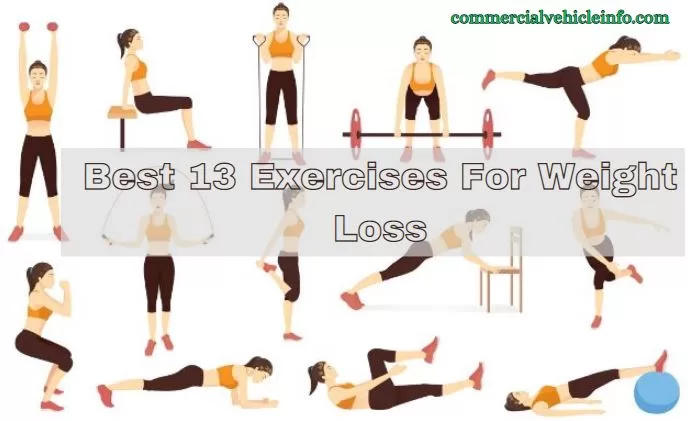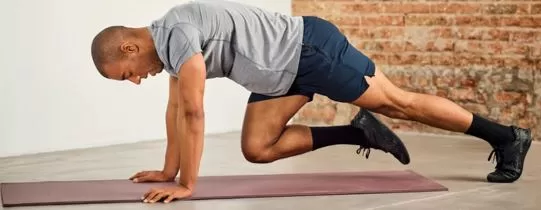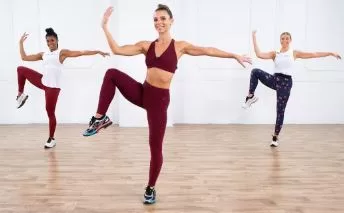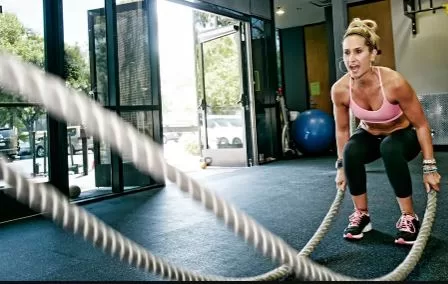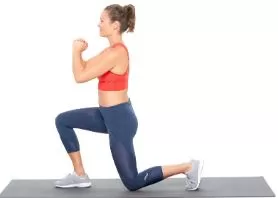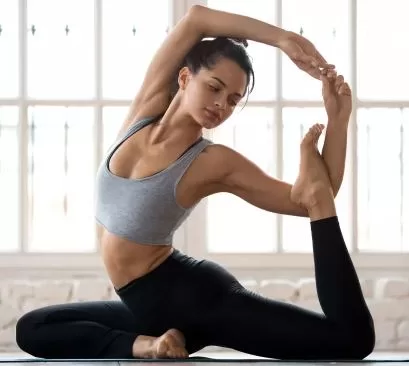Best 13 Exercises For Weight Loss Shedding those extra pounds can pose a formidable challenge, yet with the right blend of dietary adjustments and physical activity, it’s entirely within reach.
Among the integral pillars of effective weight loss, exercise holds a pivotal place, offering a myriad of options to propel you toward your desired goals.
Within the scope of this article, we will delve into a compilation of the finest 13 exercises geared toward weight loss, each of which can seamlessly become part and parcel of your workout regimen.
Best 13 Exercises For Weight Loss
In the context of weight loss, exercise emerges as a pivotal element. It holds the capacity to facilitate calorie burning, elevate metabolism, and enhance holistic well-being. Delve into the realm of the finest exercises for weight loss, as recommended by experts.
Cardiovascular Exercises
Cardiovascular workouts, also referred to as aerobic or endurance exercises, encompass activities that heavily engage aerobic metabolism. Within these exercises, the cellular reactions responsible for generating the requisite energy are heavily reliant on oxygen.
Consequently, as you partake in these exercises, your heart rate escalates, and your breathing deepens to optimize the oxygen content within your bloodstream, thereby enhancing your oxygen utilization efficiency.
Characterized by heightened heart rate and respiration, these exercises vigorously elevate both oxygen and blood circulation throughout the body. This is achieved through repetitive and rhythmic engagement of large muscle groups, underscoring the dynamic nature of cardiovascular exercises.
Brisk walking presents a straightforward and accessible workout strategy that holds potential for weight loss in both men and women. The advantages of incorporating brisk walking into a weight loss regimen span multiple dimensions, as outlined below:
- Calorie Expenditure: Brisk walking functions as an effective calorie-burning activity, a pivotal component in achieving weight loss goals. Research from Harvard Health underscores that a person weighing 155 pounds (70 kg) can shed approximately 175 calories during a half-hour session of walking at a moderate pace of 4 mph (6.4 km/h).
- Joint-Friendly Activity: As a low-impact exercise, brisk walking stands as an exercise choice that minimizes undue pressure on vulnerable joints—namely, the hips, knees, and ankles—that are prone to injury in higher-impact workout scenarios.
- Enhances Cardiovascular Well-being: By operating as a form of cardiovascular exercise, brisk walking spurs an elevation in heart rate. This, in turn, stimulates improved blood circulation and possesses the potential to reduce blood pressure levels.
- Boosts Metabolic Rate: Aiding in the elevation of metabolism, brisk walking contributes to the augmentation of daily calorie consumption. This process also supports the maintenance and growth of lean body mass, which further amplifies the quantity of calories burned on a daily basis.
- Elevates Mood: Engaging in brisk walking has the capacity to positively influence mood and alleviate manifestations of depression and anxiety. This dual benefit underscores its potential role in promoting mental well-being alongside physical fitness.
- User-Friendly Initiation: Brisk walking stands as an accessible and convenient gateway for newcomers to initiate exercise endeavors. Its simplicity and lack of necessity for specialized equipment make it an appealing option for those seeking an exercise routine that’s approachable and non-intimidating.
Jogging Exercise
- Calorie Torching: Engaging in jogging or jogging in place presents a potent means of calorie expenditure, a fundamental element in the pursuit of weight loss. According to insights from Digit Insurance, a person weighing 155 pounds (70 kg) can eliminate approximately 372 calories during a 30-minute session of jogging at a moderate pace of 5 mph (8 km/h).
- Joint-Friendly Activity: Whether in the form of jogging or jogging in place, this exercise stands as a low-impact option that minimizes undue stress on vulnerable joints such as the hips, knees, and ankles. This approach reduces the risk of injuries often associated with higher-impact workout routines.
- Enhances Cardiovascular Well-being: The practice of jogging or jogging in place qualifies as a cardiovascular activity, resulting in an elevated heart rate. This elevation serves to enhance blood circulation, subsequently contributing to potential reductions in blood pressure.
- Stokes Metabolic Fires: The act of jogging or jogging in place plays a role in elevating metabolic rate, leading to the continued consumption of calories even after the workout has concluded. This phenomenon, referred to as excess post-exercise oxygen consumption (EPOC), can significantly contribute to the overall process of weight loss.
- User-Friendly Commencement: The simplicity of jogging or jogging in place renders it an approachable and convenient option for newcomers to initiate their exercise journey. Its accessibility negates the need for complex equipment and minimizes feelings of overwhelm, making it an ideal starting point.
Cycling Exercises
- Calorie Incineration: Engaging in cycling delivers an aerobic workout that effectively burns calories, a pivotal component for achieving weight loss. As outlined by Better Health Victoria, an individual weighing 70 kg can eliminate approximately 420-620 calories within an hour of cycling at a moderate pace.
- Facilitates Fat Reduction: Cycling emerges as a strategy for weight loss by facilitating the combustion of fat, with a particular emphasis on targeting abdominal adipose tissue. This activity activates the abdominal muscles and concurrently enhances the broader process of fat metabolism.
- Amplifies Metabolic Activity: Cycling contributes to an escalation in metabolic rate, resulting in the continued consumption of calories even after the exercise session concludes. This phenomenon, recognized as excess post-exercise oxygen consumption (EPOC), stands as a significant contributor to the overall weight loss process.
- Joint-Friendly Endeavor: As a low-impact exercise, cycling ensures that undue strain is avoided on vulnerable joints such as the hips, knees, and ankles. This characteristic reduces the susceptibility to injuries commonly associated with higher-impact workout routines.
- Enhances Cardiovascular Well-being: Cycling operates as a cardiovascular workout, fostering both heart strength and overall cardiovascular fitness. Its positive effects extend to the reduction of heart disease risk and other related cardiovascular conditions.
- Augments Stamina and Endurance: Regular participation in cycling leads to the enhancement of both stamina and endurance levels. This enhancement enables longer exercise durations, thereby contributing to increased calorie expenditure.
Swimming Exercises
- Calorie Immolation: Swimming emerges as an aerobic endeavor capable of torching calories, an indispensable element in the pursuit of weight loss. As indicated by Form Swim, an individual weighing 70 kg can eliminate approximately 340 calories during a 30-minute swimming session.
- Joint-Friendly Engagement: Swimming stands as a low-impact activity, alleviating undue strain on joints such as the hips, knees, and ankles that are susceptible to injury during more high-impact workouts.
- Holistic Muscle Activation: Swimming constitutes a comprehensive workout that engages major muscle groups throughout the body. This comprehensive engagement fosters the fortification of the entire physique and cultivates muscular strength through a singular aquatic exercise.
- Enhances Cardiovascular Fitness: Swimming operates as a cardiovascular pursuit that bolsters heart strength and overall cardiovascular well-being. Its positive impact encompasses the reduction of heart disease risk and other conditions related to cardiovascular health.
- Amplifies Respiratory Capacity: Engaging in swimming aids in the augmentation of lung capacity and the refinement of breathing control, thereby contributing to improved respiratory function.
- Stress Alleviation: Swimming serves as a means of stress reduction, promoting relaxation and tranquility amid the water’s embrace.
- Universal Accessibility: The advantages of swimming extend to individuals across all age groups and fitness levels. Its low-impact nature ensures its suitability for people of varying physical conditions and levels of fitness.
Jumping rope Exercises
- Calorie Ignition: The act of jumping rope constitutes a high-intensity exercise renowned for its capacity to incinerate a substantial number of calories. Characterized as a vigorous-intensity activity, it triggers an elevation in heart rate, consequently fostering enhanced calorie expenditure.
- Comprehensive Muscular Engagement: Jumping rope involves the activation of numerous muscle groups spanning the legs, arms, core, and shoulders. This engagement culminates in a comprehensive full-body workout that actively contributes to the development of strength and endurance.
- Enhances Cardiovascular Well-being: Jumping rope functions as a cardiovascular pursuit that bolsters heart strength and elevates overall cardiovascular fitness. By amplifying heart rate, enhancing blood circulation, and advancing cardiovascular endurance, this activity significantly contributes to heart health.
- Cultivates Coordination and Agility: The act of jumping rope necessitates coordination and precise timing, imparting improvements in motor skills, balance, and agility. This dual benefit enhances overall physical coordination.
- Portable and Budget-Friendly: The exercise of jumping rope holds the advantage of portability and affordability. Virtually executable anywhere, it demands only a jump rope, an inexpensive and effortlessly portable piece of equipment.
- Versatility and Enjoyment: Jumping rope presents an array of workout possibilities, encompassing diverse jumping styles, intervals, and variations. Its flexibility renders it an enjoyable and dynamic exercise that consistently injects novelty and engagement into workouts.
Rowing Exercises
- Calorie Incineration: Rowing emerges as a dynamic full-body workout that enlists multiple muscle groups, positioning it as an exceptionally effective calorie-burning endeavor. Its capacity to generate a calorie deficit underscores its pivotal role in achieving weight loss goals.
- Holistic Muscle Engagement: The practice of rowing engrosses muscles in the arms, legs, back, and core, culminating in a comprehensive full-body workout. This engagement contributes to the cultivation of strength and endurance, simultaneously sculpting and toning various muscle groups.
- Cardiovascular Vitality: Rowing stands out as a superb cardiovascular activity, bolstering heart strength and enhancing overall cardiovascular fitness. It exerts a positive influence on lung capacity and optimizes the efficiency of the cardiovascular system.
- Gentle on Joints: With its low-impact nature, rowing imposes minimal stress on joints, making it an apt choice for individuals grappling with joint concerns or seeking a low-impact workout alternative.
- Weight Management and Body Composition: Rowing operates as a catalyst for weight loss through the combined effects of calorie expenditure and fat reduction. Beyond weight loss, it contributes to improved body composition by reducing body fat and fostering the growth of lean muscle mass.
- Posture Refinement and Core Empowerment: Rowing mandates proper posture and actively involves core muscles, thus enhancing both postural alignment and the strength of abdominal muscles.
- Versatility and Enjoyment: The versatility of rowing is exemplified by its feasibility on a rowing machine or on open water. This adaptability accommodates varying preferences and introduces an element of enjoyment and engagement that keeps workout routines intriguing.
Dancing Exercises
- Calorie Ignition: Embracing the rhythm of dance offers a vibrant method to torch calories and initiate weight loss. Depending on the intensity and duration of the dance, it can facilitate the expenditure of anywhere from 200 to 500 calories per hour.
- Comprehensive Muscular Engagement: Dance artfully engages diverse muscle groups, creating a holistic full-body workout experience. This fusion of movement not only contributes to strength and endurance but also sculpts and tones muscles throughout the body.
- Enhances Cardiovascular Well-being: Dance emerges as an exceptional cardiovascular pursuit, elevating heart strength and enhancing overall cardiovascular fitness. It effectively heightens lung capacity and optimizes the operational efficiency of the cardiovascular system.
- Gentle on Joints: As a low-impact activity, dance exerts minimal strain on joints, rendering it a favorable option for individuals grappling with joint sensitivities or those in search of a low-impact exercise avenue.
- Coordination and Balance Enhancement: Dancing necessitates coordination and impeccable timing, facilitating an improvement in motor skills, balance, and overall agility.
- Stress Alleviation: Dance offers a path to stress reduction and encourages relaxation through the expressive movements and rhythmic flow.
- Enjoyment and Social Interaction: The act of dancing isn’t solely a workout but a source of enjoyment and social connection. It provides an avenue for reveling with friends or groups, enabling interactions, and fostering new friendships.
Stair climbing Exercises
- Calorie Torching: The act of stair climbing stands as a notably effective approach for calorie incineration and the promotion of weight loss. It emerges as one of the prime exercises for pure fat burning, effectively aiding in toning the lower body regions, including the buttocks, thighs, and calves.
- Enhanced Cardiovascular Fitness: Engaging in stair climbing yields benefits for heart and lung strength, significantly elevating aerobic fitness. It broadens lung capacity, facilitating increased oxygen intake, while concurrently optimizing the cardiovascular system’s efficiency. This results in more effective pumping of oxygen-rich blood to muscles and vital organs.
- Supports Bone Health: The weight-bearing nature of stair climbing contributes to the reduction of osteoporosis risk and the promotion of increased bone mass. This attribute holds particular significance as we age, given the tendency for natural bone loss to escalate over time.
- Muscle Empowerment: The act of stair climbing calls upon major muscle groups including the quadriceps, hamstrings, glutes, and calves, all of which are crucial for strength and tone. This workout effectively challenges and fortifies the lower body.
- Caloric Expenditure: Stair climbing translates into a calorie-consuming endeavor, thereby contributing to weight loss by fostering a calorie deficit—a prerequisite for shedding excess pounds.
- Ease and Accessibility: The versatility of stair climbing is underscored by its applicability nearly anywhere. It can encompass ascending stairs at home, in buildings, or utilizing a stair climber machine at a fitness facility. This convenience and accessibility render stair climbing a practical and achievable exercise choice.
High-Intensity Interval Training (HIIT)
High-Intensity Interval Training (HIIT) stands as a workout method characterized by brief bursts of vigorous activity interspersed with periods of rest. This approach offers a multitude of weight loss benefits, supported by diverse sources:
- Calorie Inferno: HIIT emerges as an exceptionally potent mechanism for torching calories and advancing weight loss objectives. It outpaces traditional, steady-state cardio exercises in caloric expenditure, achieving more within a shorter timeframe.
- Holistic Muscle Activation: HIIT ingeniously engages multiple muscle groups, imparting a holistic full-body workout experience. This holistic approach fosters strength and endurance development while simultaneously sculpting and toning muscles.
- Enhances Cardiovascular Vitality: HIIT assumes the role of an exemplary cardiovascular pursuit, strengthening the heart and fostering overall cardiovascular fitness. This translates to enhanced lung capacity and amplified cardiovascular system efficiency.
- Elevates Metabolic Function: HIIT stimulates an elevation in metabolic rate, resulting in sustained calorie consumption even after the workout concludes. This phenomenon, recognized as excess post-exercise oxygen consumption (EPOC), significantly contributes to weight loss efforts.
- Optimal Time Utilization: HIIT workouts generally demand less time than traditional steady-state cardio regimens, making them an efficient alternative for individuals with busy schedules.
- Diversity and Enjoyment: HIIT can be adapted to various exercises, spanning bodyweight movements, cardio machines, and free weights. This inherent versatility renders HIIT a pleasurable and captivating exercise strategy, constantly infusing novelty into workout routines.
Strength Training
- Strength training progressively enhances muscle force output through diverse exercises and equipment. This approach involves overloading muscle groups, contracting against resistance and repeating until reaching muscle failure.
- Primarily anaerobic, strength training utilizes progressive overload, where muscles face resistance that spurs growth.
- Consistent training cultivates stronger muscles, bolstering posture, balance, coordination, bone density, and reducing osteoporosis risk. It aids weight management, betters cardiovascular health, and elevates overall fitness and life quality.
- Proper technique is crucial to prevent injury. Seek assessment and tailored programs, adhere to medical advice, and learn exercises from experts.
- Strength training suits various environments—home, gym, outdoors. Prioritize proper form, gradually intensify workouts, and recognize its manifold health gains.
Squats Exercises
Squats: Effective lower body exercise engaging multiple muscles. Execution:
- Bend knees, lower hips as if sitting back in a chair.
- Maintain chest up, straight back, engaged core.
- Lower till thighs parallel to ground or form allows.
- Push through heels to return.
Benefits:
- Strengthens lower body: Targets quads, hamstrings, glutes, calves, and core.
- Enhances everyday movements: boosting functional strength and mobility.
- Improves sports performance: Benefits running, jumping, and lifting.
- Amplifies calorie burn: Engages many muscles, aiding calorie expenditure and weight loss.
- Enhances athletic performance:Fortifying core enhances posture.
- Boosts calorie burn:Increases bone density, and lessens osteoporosis risk.
- Versatile and accessible: Weighted or unweighted, adaptable for different levels and settings.
Lunges Exercises
- Stand hip-width apart.
- Step forward with one foot, bending both knees.
- Keep front knee aligned with ankle, back knee above ground.
- Push through the front heel to return.
- Repeat on the other side.
Benefits:
- Strengthens lower body: Targets quads, hamstrings, glutes, calves, core.
- Enhances functional movement: Mimics daily actions, improving overall strength and mobility.
- Elevates athletic performance: Benefits running, jumping, and lifting.
- Amplifies calorie burn: Engages multiple muscles, aiding calorie expenditure and weight loss.
- Increases bone density, and reduces osteoporosis risk.
- Versatile and accessible: Weighted or unweighted, adaptable for different levels and settings.
Deadlifts Exercises
Deadlifts are a compound exercise engaging multiple muscle groups. A breakdown from sources:
- Muscles involved: Hamstrings, glutes, back, hips, core, trapezius. Comprehensive strength enhancement.
- Strength and muscle: Known for overall strength and muscle mass development, particularly for a robust back.
- Functional mimicry: Replicates real-world lifting actions, boosting functional strength and mobility.
- Injury prevention: Reinforces muscles, connective tissues, enhancing joint stability and injury prevention.
- Core stability: Requires engaged core for form and stability, fortifying core muscles and overall stability.
- Bone density boost: Weight-bearing, enhances bone density, and reduces osteoporosis risk.
- Versatility: Varied types—conventional, sumo, Romanian—tailor to muscle targeting, individual choices.
Bench Press Exercises
The bench press, a compound exercise, hones in on the chest, shoulders, and triceps, serving as a prominent and effective upper-body workout. Here’s a breakdown of bench press execution and its merits:
- Lie under the bar on a bench.
- Grip bar with medium width, thumbs around it.
- Unrack the bar by extending your arms.
- Lower bar to mid-chest.
- Press the bar up until the arms straighten.
Merits
- Upper body strength and muscle development: Effective for chest, shoulder, and triceps strength and muscle gain.
- Whole-body involvement: Beyond the upper body, the back, glutes, and core contribute to holistic strength and stability.
- Chest activation: Maximally activates chest muscles, promoting chest strength and growth.
- Versatility: Customizable for goals and levels by adjusting weight, grip, incline/decline. Targets muscles or meets preferences.
- Strength and functional motion: Elevates upper body strength, aiding daily activities, and sports performance. Enhances pushing strength and functional movement.
Yoga Exercises
Yoga, a versatile practice, presents an array of advantages for weight loss, muscle development, and stress alleviation. Highlighting prime yoga poses for weight loss:
- Warrior: Aims at legs, hips, and core. Stance with wide feet, arms parallel, front knee bent, back leg extended straight.
- Downward-facing dog: Engages full body—arms, shoulders, core, legs. Start on all fours, lift hips back, and heels press down.
- Tree pose: Balancing act, engages core, and legs. Stand on one leg, opposite foot on thigh or calf, hands together at the chest.
- Triangle pose: Stretches and strengthens—legs, hips, and core. Wide stance, arms out, bend sideways at the waist.
Yoga’s Weight Loss Benefits:
- Muscle growth: Yoga fosters strength, muscle tone, bolstering metabolism and calorie expenditure.
- Stress relief: Yoga integrates deep breathing, mindfulness reducing stress, curbing emotional eating, and aiding weight management.
- Flexibility enhancement: Consistent yoga betters flexibility, enriching motion range and physical performance.
- Mind-body harmony: Holistic fitness approach, nurturing self-awareness, positive body relationship.
Pilates Exercises
Pilates stands out as a potent weight loss method, nurturing muscle growth, flexibility, and holistic well-being. Unveiling top Pilates exercises for weight loss:
- The Hundred: Aids core and body strength via back lying, head and shoulder lifting, arm pumping, all while anchoring a stable core.
- Roll-up: Enhances core strength by progressing from back lying to seated with extended arms, all while engaging the core.
- Single leg circles: Hones hip flexors, glutes, and core by performing leg circles while stabilizing the core.
- Criss-cross: Strengthens oblique muscles as you twist and extend legs, bolstering core vitality.
Benefits of Pilates for Weight Loss:
- Full-body activation: Engages multiple muscle groups, fostering comprehensive toning and weight loss.
- Enhanced flexibility: Elevates flexibility, mitigating injury risk while enriching movement.
- Fortified core: Emphasizes core engagement, elevating posture, stability, and overall strength.
- Low impact: Gentle on joints, accessible to varied fitness levels and ages.
- Mind-body fusion: Uplifts mindfulness and body awareness, fostering holistic fitness and well-being.
Boxing Exercises
Boxing, a high-intensity regimen, delivers an array of advantages for cardiovascular health, muscle gain, and stress alleviation. Unveiling top boxing exercises and merits:
- Boxing Combinations: Series of punches, kicks multi-muscle targeting, heart rate elevation bolsters endurance, calorie burn.
- Shadowboxing: Solo activity punches, movement as if against an imaginary opponent enhances coordination, speed, technique, and comprehensive body workout.
- Heavy Bag Workout: Strikes on heavy bag resistance, upper body, and core strength amplifies endurance and coordination.
- Jump Rope: Simple yet effective boosts cardiovascular health, coordination, and agility. Calorie burn, seamless inclusion in boxing routine.
Benefits of Boxing Exercises:
- Cardiovascular Health: High-intensity heightened heart rate, cardiovascular endurance enhancement curbing heart disease risk, promoting overall health.
- Muscle Growth: Engages arms, shoulders, core, legs promotes muscle mass, strength escalation.
- Stress Relief: Releases tension, aggression mindfulness, relaxation promotion, nurturing mental well-being.
- Versatility: Tailorable to fitness levels, goals adaptable for various ages, and abilities.
Benefits of Exercise For Weight Loss
Exercise stands as a fundamental cornerstone within any comprehensive weight loss strategy, extending its benefits far beyond the realm of shedding pounds.
Here, we outline several advantages of incorporating exercise into your weight loss journey :
- Controls weight: By engaging in physical activities, you effectively thwart the accumulation of excess weight and foster the sustenance of weight loss. The act of exercising expends calories, with the intensity of the activity directly influencing the calorie expenditure.
- Increases metabolism: Exercise wields the power to elevate your metabolism, amplifying the number of calories your body naturally burns on a daily basis. This, in turn, aids in the preservation and augmentation of lean body mass, further intensifying your daily calorie consumption.
- Improves cardiovascular health: Regular exercise possesses the capability to lower blood pressure and reduce cholesterol levels, thereby serving as a potential safeguard against heart attacks.
- Reduces the risk of chronic diseases: By integrating exercise into your routine, you can potentially stave off the onset of specific diseases or even reverse their effects. A prime example is its impact on mitigating the risk of type 2 diabetes.
- Boosts mood: The influence of exercise transcends the physical realm, profoundly impacting your emotional well-being. Engaging in exercise can substantially uplift your mood, alleviating symptoms of depression and anxiety.
- Increases energy levels: Rather than draining your energy, exercise has the remarkable ability to heighten your energy levels and counteract feelings of fatigue.
- Promotes better sleep: Exercise contributes to enhancing the quality of your sleep and expediting the process of falling asleep, thereby fostering improved sleep patterns.
Conclusion
Exercise is an essential component of any weight loss plan. By incorporating these 13 exercises into your workout routine, you can burn calories, build muscle, and achieve your weight loss goals.
Visit our Website at Commercialvehicleinfo.com for Additional Details.
FAQs
Walking, jogging or running, cycling, weight training, interval training, swimming, and resistance exercises are among the best exercises for weight loss.
For healthy weight loss, it is recommended to incorporate at least 150 minutes of moderate aerobic activity or 75 minutes of vigorous aerobic activity per week, along with strength training exercises that target major muscle groups two to three times a week.
While exercise is an important component of weight loss, it is possible to lose weight through dietary changes alone. However, combining exercise with a healthy eating plan is generally more effective for long-term weight loss and overall health.
There is no single best exercise for weight loss, as different exercises work better for different individuals. It is important to choose exercises that you enjoy and can incorporate into your routine consistently.
The duration of exercise for weight loss can vary depending on individual fitness levels and goals. It is recommended to aim for at least 150 minutes of moderate aerobic activity or 75 minutes of vigorous aerobic activity per week.
Yes, walking is considered one of the best exercises for weight loss. Walking at a fast pace can help burn calories and is a low-impact exercise that can be easily incorporated into daily activities.
Yes, home exercises can be effective for weight loss. Walking, bodyweight exercises, yoga, and other home workout programs can help burn calories and improve fitness levels.
Yes, strength training exercises can help with weight loss. Building muscle through strength training can increase metabolism and burn more calories even at rest.
Yes, high-intensity interval training (HIIT) workouts can be highly effective for weight loss. HIIT involves short bursts of intense exercise followed by periods of rest, which can help burn calories and improve cardiovascular fitness.
Yes, swimming is a great exercise for weight loss. It is a low-impact activity that can burn a significant amount of calories and improve overall fitness.
Yes, cycling is an effective exercise for weight loss. It improves cardiovascular fitness, burns calories, and can be done both outdoors and indoors on stationary bikes.
Yes, yoga and Pilates can be effective for weight loss. These exercises help build muscle, improve flexibility, reduce stress, and promote overall well-being.
